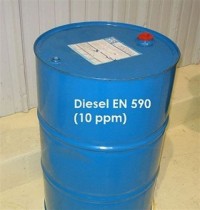


EN590 is the European standard for automotive diesel fuel, designed to ensure high-quality, low-emission fuel for diesel-powered vehicles. It is widely used in Europe and other regions for both road transport and industrial applications, offering compatibility with modern engines and emission control systems.
- Sulfur Content: Ultra-low sulfur diesel (ULSD) with a maximum of 10 ppm (parts per million) of sulfur. This specification helps minimize harmful emissions, making EN590 compliant with stringent European Union environmental regulations.
- Cetane Number: A minimum of 51, ensuring high combustion efficiency, smooth engine performance, and reduced exhaust emissions.
- Density: The density of EN590 typically ranges between 820–845 kg/m³ at 15°C. The exact value depends on the specific grade of fuel, and variations in density influence fuel consumption and engine efficiency.
- Flash Point: A minimum of 55°C, which is crucial for the safe handling, storage, and transportation of the fuel.
- Cold Flow Properties: EN590 diesel is available in different climatic grades to address cold weather conditions. It is formulated to prevent fuel gelling and ensure smooth engine start-ups in low temperatures.
- Road Transport: EN590 diesel is used in vehicles such as trucks, buses, and cars, meeting Euro 5 and Euro 6 emission standards.
- Industrial Machinery: The fuel is also used in machinery for construction, agriculture, and other industrial sectors, where reliable performance and lower emissions are critical.
- Marine Applications: EN590 can be utilized in certain marine diesel engines, providing clean, efficient fuel for vessels operating within regulated emission zones.
- Traded Quantities: EN590 is commonly traded in metric tons or barrels, with global pricing influenced by crude oil prices, refining costs, and regional demand.
- Sourcing Regions: The fuel is primarily sourced from refineries in Europe, Russia, the Middle East, and Asia. European refiners are the primary producers, but other regions also play a significant role in meeting global demand.